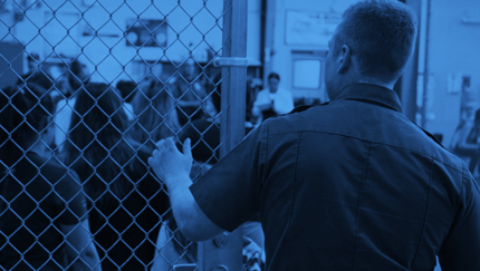Research and Analysis

Bordering on Criminal: The Routine Abuse of Migrants in the Removal System
This two-part series highlights the findings of the Migrant Border Crossing Study—a binational, multi-institution study of 1,110 randomly selected, recently repatriated migrants surveyed in six Mexican cities between 2009 and 2012. The study exposes widespread mistreatment of migrants at the hands of U.S. officials in the removal system. Part I: Migrant Mistreatment While in U.S. Custody This report focuses on the mistreatment of unauthorized migrants while in U.S. custody. Overall, we find that the physical and verbal mistreatment of migrants is not a random, sporadic occurrence but, rather, a systematic practice. One indication of this is that 11% of deportees report some form of physical abuse and 23% report verbal mistreatment while in U.S. custody—a finding that is supported by other academic studies and reports from non-governmental organizations. Another highly disturbing finding is that migrants often note they are the targets for nationalistic and racist remarks—something that in no way is integral to U.S. officials’ ability to function in an effective capacity on a day-to-day basis. Read More

The Cost of Immigration Enforcement and Border Security
Since the creation of the Department of Homeland Security in 2003, the federal government has spent an estimated $324 billion on the agencies that carry out immigration enforcement. Read More

Stepping Up: The Impact of the Newest Immigrant, Asian, and Latino Voters
This analysis of immigration trends and the demographic composition of U.S. House districts shows that numerous congressional districts have emerging electorates who have many reasons to care deeply about immigration reform. Read More

How DACA is Impacting the Lives of Those Who are Now DACAmented
As Congress continues to debate immigration reform, August 15th marks the one-year anniversary of the Deferred Action for Childhood Arrivals (DACA) program. While not granting a path to legalization and citizenship, DACA provides an opportunity for a segment of the undocumented immigrant population to… Read More

The Criminal Alien Program (CAP): Immigration Enforcement in Prisons and Jails
The Criminal Alien Program (CAP) is an expansive immigration enforcement program that leads to the initiation of removal proceedings in many cases. While CAP has existed in one form or another for decades, there is still much to be learned about the program, how it is organized, and how it works. What is known is that CAP extends to every area of the country and intersects with most state and local law enforcement agencies. For years, the CAP program has operated with little public attention and many of its elements have only recently come to light following FOIA litigation against Immigration and Customs Enforcement (ICE). The information obtained through the lawsuit regarding CAP’s current organization and staffing suggests CAP is not a single program, but a loose-knit group of several different programs operating within ICE. Other than a small number of staff responsible for the administration of CAP at ICE headquarters, there is no dedicated CAP staff. Rather, ICE pulls personnel and resources from across the agency to perform CAP-related functions. The ICE declarations and deposition also explain how CAP functions within prisons and jails. There appears to be little consistency in, and little or no policy governing, how CAP cooperates with state and local law enforcement agencies in different regions and in how CAP interacts with detainees in different facilities. Instead, CAP appears to function as an ad hoc set of activities that operate differently across the country and across penal institutions, raising questions about the adequacy of oversight, training, and accountability of the personnel implementing CAP. This information confirms that there is still much about CAP that remains unknown or unclear. Given the breadth of CAP, the centrality of its role in immigration enforcement, and its large impact on the immigrant community, it is critical that ICE clarify how CAP operates. Read More

Tackling the Toughest Questions on Immigration Reform
Despite significant public support for immigration reform among members of the public in both parties, many of the most basic facts about immigrants and immigration remain misunderstood. Read More

An Unlikely Couple: The Similar Approaches to Border Enforcement in H.R. 1417 and S. 744
The House of Representatives and the Senate have embarked upon very different paths when it comes to immigration reform. On June 27, the Senate passed a comprehensive immigration reform bill—S. 744 (the Border Security, Economic Opportunity, and Immigration Modernization Act)—that seeks to revamp practically every dysfunctional component of the U.S. immigration system. The House leadership, on the other hand, favors a piecemeal approach in which a series of immigration bills are passed, each addressing a different aspect of the larger immigration system. To date, the most popular of these piecemeal bills has been H.R. 1417 (the Border Security Results Act), which was passed unanimously on May 15 by the House Committee on Homeland Security. H.R. 1417 is, in marked contrast to S. 744, an enforcement-only bill which does not acknowledge the existence of any other component of immigration reform. Nevertheless, the border-enforcement provisions of S. 744 aren’t all that different from those contained within H.R. 1417. Both bills share the arbitrary and possibly unworkable goals of “operational control” (a 90 percent deterrence rate) and 100 percent “situational awareness” along the entire southwest border. The Senate bill also added insult to injury in the form of the Corker-Hoeven (“border surge”) amendment, which seeks to micromanage border-security operations and would gratuitously appropriate tens of billions of dollars in additional funding, and hire tens of thousands of additional Border Patrol agents, before the Department of Homeland Security (DHS) has even determined what resource and staffing levels are needed to do the job. Read More

A Guide to S.744: Understanding the 2013 Senate Immigration Bill
This guide to provide policymakers, the media, and the public with an easy-to-understand guide to the main components of S. 744 and the purpose behind them. Read More

The Power of Reform: CBO Report Quantifies the Economic Benefits of the Senate Immigration Bill
According to the Congressional Budget Office (CBO) and Joint Committee on Taxation (JCT), the fiscal and economic effects of the Senate immigration reform bill (S. 744) would be overwhelmingly positive. If enacted, the bill would help reduce the federal budget deficit by approximately $1 trillion over 20 years, would boost the U.S. economy as whole without negatively affecting U.S. workers, and would greatly reduce future undocumented immigration. These are the conclusions laid out in three reports released in June and July 2013. On June 18, the CBO issued two reports on the version of S. 744 that was reported out of the Senate Judiciary Committee on May 28. The first one analyzes (or “scores”) the fiscal impact of the bill over the next 20 years and the second one focuses on the impact that some aspects of the bill would have on the U.S. economy. On July 3, the CBO issued a revised score on the version of the bill that passed the Senate on June 27. This version includes the Corker-Hoeven “border surge” amendment, which calls for a significant increase in border-enforcement spending. What is a CBO score and what are its main implications? Nearly every bill that is approved by a full committee of either house of Congress is subject to a formal cost estimate by the CBO. The report produced as a result of this analysis is known as the CBO “score.” The purpose of this analysis is to aid in economic and budgetary decisions on a wide assortment of programs covered by the federal budget. In general, the CBO estimates what the net fiscal impact of a bill would be, considering both the costs and the benefits associated with its implementation. Read More

Crafting a Successful Legalization Program: Lessons From the Past
One of the themes that emerged from the Senate Judiciary Committee mark up of the 2013 Senate immigration bill was the necessity of avoiding the mistakes of the past. In the context of legalization for the 11 million unauthorized immigrants now in the United States, the argument is often made that the 1986 law wasn’t tough enough, and any new legalization program should have more requirements and restrictions. However, in my 39-year career with the Department of Homeland Security (DHS) and former Immigration and Naturalization Service (INS), and after years of studying implementation of the 1986 law, I’ve reached a different conclusion. A successful legalization program depends on simplicity and common sense. There are many lessons to be learned from the 1986 law about how to design a better legalization program. Fortunately, many of those lessons have been absorbed by the drafters of S. 744, the Border Security, Economic Opportunity and Immigration Modernization Act. Nonetheless, as the debate continues on this bill, it is important to reiterate the importance of good design and thoughtful implementation. That is what will ensure success and provide the country with a working immigration system. Read More
Make a contribution
Make a direct impact on the lives of immigrants.
